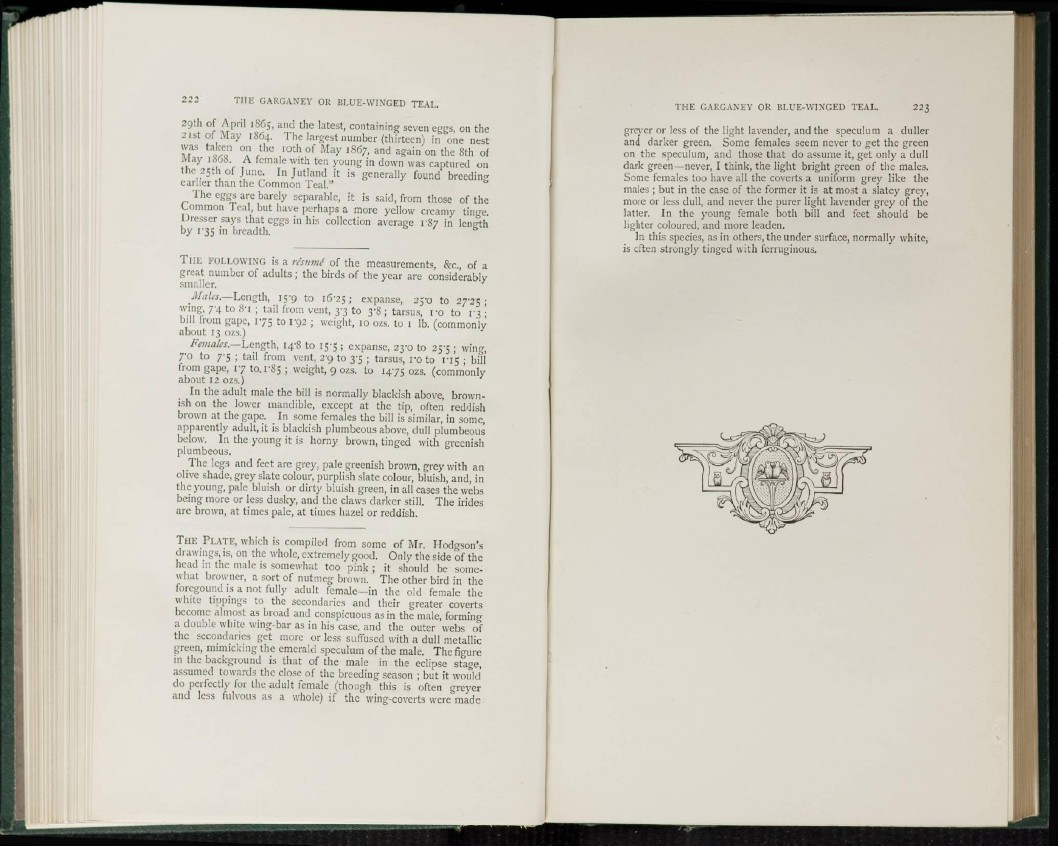
29th of April 1SG5, and the latest, containing seven eggs, on the
21 st of May 1864. The largest number (thirteen) in one nest
was taken on the 10th of May 1867, and again on the 8th of
May 1S6S. A female with ten young in down was captured on
the 25th of June. In Jutland it is generally found breeding
earlier than the Common Teal."
The eggs are barely separable, it is said, from those of the
Common Teal, but have perhaps a more yellow creamy tinge.
Dresser says that eggs in his collection average i'87 in length
by 1 '35 in breadth.
THE FOLLOWING is a rtsumi of the measurements, &c, of a
great number of adults ; the birds of the year are considerably
smaller.
Males.—Length, 159 to l6'25; expanse, 25X) to 27^25;
wing, 7 4 to S'l ; tail from vent, 33 to 3'8 ; tarsus, r o to 1-3 ;
bill from gape, 175 to i'92 ; weight, 10 ozs. to 1 lb. (commonly
about 13 ozs.)
Females.—Length, I4'8 to 15-5 ; expanse, 23^0 to 25'5 ; wing,
7'0 to 7'5 ; tail from vent, 2-9 to 3'5 ; tarsus, ro to r i 5 ; bill
from gape, 17 to. rS5 ; weight, 9 ozs. to 1475 ozs. (commonly
about 12 ozs.)
In the adult male the bill is normally blackish above, brownish
on the lower mandible, except at the tip, often reddish
brown at the gape. In some females the bill is similar, in some,
apparently adult, it is blackish plumbeous above, dull plumbeous
below. In the young it is horny brown, tinged with greenish
plumbeous.
The legs and feet are grey, pale greenish brown, grey with an
olive shade, grey slate colour, purplish slate colour, bluish, and, in
the young, pale bluish or dirty bluish green, in all cases the webs
being more or less dusky, and the claws darker still. The irides
arc brown, at times pale, at times hazel or reddish.
THE PLATE, which is compiled from some of Mr. Hodgson's
drawings, is, on the whole, extremely good. Only the side of the
head in the male is somewhat too pink ; it should be somewhat
browner, a sort of nutmeg brown. The other bird in the
forcgound is a not fully adult female—in the old female the
white tippings to the secondaries and their greater coverts
become almost as broad and conspicuous as in the male, forming
a double white wing-bar as in his case, and the outer webs of
the secondaries get more or less suffused with a dull metallic
green, mimicking the emerald speculum of the male. The figure
in the background is that of the male in the eclipse stage,
assumed towards the close of the breeding season ; but it would
do perfectly for the adult female (though this is often greyer
and less fulvous as a whole) if the wing-coverts were made
greyer or less of the light lavender, and the speculum a duller
and darker green. Some females seem never to get the green
on the speculum, and those that do assume it, get only a dull
dark green—never, I think, the light bright green of the males.
Some females too have all the coverts a uniform grey like the
males ; but in the case of the former it is at most a slatey grey,
more or less dull, and never the purer light lavender grey of the
latter. In the young female both bill and feet should be
lighter coloured, and more leaden.
In this species, as in others, the under surface, normally white,
is often strongly tinged with ferruginous.